Welcome to a journey through the colorful and diverse linguistic landscape of Gambia. This vibrant West African nation is not only renowned for its natural beauty but also for its cultural richness, prominently showcased through the languages spoken Gambia. As the official languages Gambia take root in its colonial past, English stands at the helm of formal communication, used extensively for education and official affairs. Yet, it is the melodious orchestra of indigenous tongues, each contributing to the nation’s unique linguistic heritage Gambia, that truly makes it a polyglot’s paradise.
From bustling marketplaces echoing in Mandinka to tranquil villages where Pulaar whispers through the streets, the nation’s tongues are as varied as its landscapes. In every corner of Gambia, from the verdant banks of the river that gives the country its name to the sandy stretches of its Atlantic coastline, language is a vivid expression of Gambian identity and experience.
Key Takeaways
- English serves as Gambia’s official language, a legacy of its British colonial history.
- Mandinka is the most widely spoken first language, reflecting the true voice of many Gambians.
- Gambian linguistic diversity is further enriched by languages like Pulaar, Wolof, and several others.
- Each indigenous language adds to the rich tapestry of Gambia’s cultural and linguistic heritage.
- The use of Gambian Sign Language is also an important aspect of inclusivity in communication.
- Multilingualism is a common thread, with many Gambians fluent in multiple languages including English.
Exploring the Language Diversity of Gambia
In the heart of West Africa, the Gambia radiates a rich palette of languages reflective of the nation’s varied ethnicities and their vibrant cultures. Each region’s dialectal pitch adds an idiosyncratic tone to the linguistic melody playing throughout the country. To explore the language diversity in Gambia is to traverse a language map intricately woven with indigenous tongues and dialects, each a testimony to the ethnic and historical narratives that have shaped the nation.
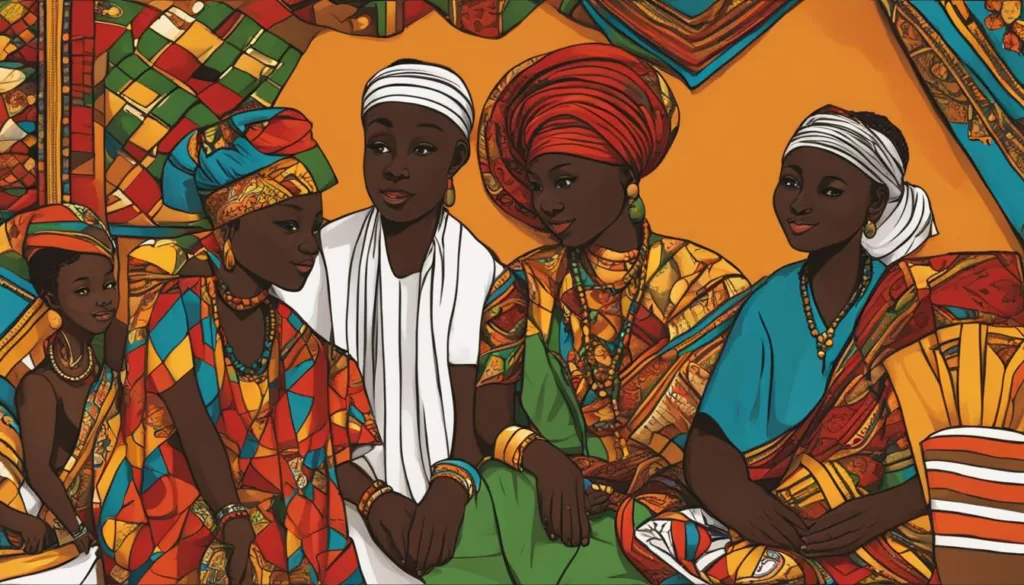
The Ethnic and Linguistic Tapestry
With a national mosaic composed of diverse ethnic groups, the Gambia presents a linguistic tapestry rich with native tongues and traditions. The Mandinka language takes the lead, spoken as a first language by a significant portion of the population, while Pulaar, Wolof, and Soninke are also prominent in the country’s language tapestry. These local languages of Gambia not only facilitate daily communication but also carry the imprint of the nation’s cultural depth.
Gambian dialects, each with their own hints of lexical and phonetic distinctiveness,are nuanced representations of the intricate sociocultural relationships existing among the various communities. Beyond mere communication, these dialects serve as crucial components of identity for the Gambian people, offering us a glimpse into their rich heritage and collective spirit.
How Language Reflects Gambia’s Culture and Identity
The linguistic diversity in Gambia is a colorful reflection of its cultural identity and history. Language here is more than a tool of verbal expression; it is an emblem of belonging, a source of pride, and an inheritance passed on through generations. The language map of Gambia—illustrated by more than ten languages and their respective dialects—is a testament to the communal fabric, consisting of stories, traditions, and the shared humanity of its people.
- Mandinka, the melody of the majority
- Pulaar, whispering the tales of the Fula people
- Wolof, echoing the sentiments of the Wolof tribe
- Soninke and Jola, narrating histories in their unique linguistic rhythms
As you navigate through the daily life in Gambia, from the markets to the schools, the diversity of languages provides a sonic backdrop to the scenes of traditional and modern life intertwining. And within this multitude of voices, a unified Gambian identity takes form, grounded in mutual understanding and cultural respect.
Languages Spoken Gambia: A Multilingual Nation
The Gambia, a small yet linguistically grand nation in West Africa, is characterized by a symphony of tongues that resonate throughout its borders. It is home to an array of national languages Gambia that bring vibrancy and color to everyday interactions among its populations. This multilingual country echoes with stories told in the rich textures of languages spanning from the indigenous to the global.
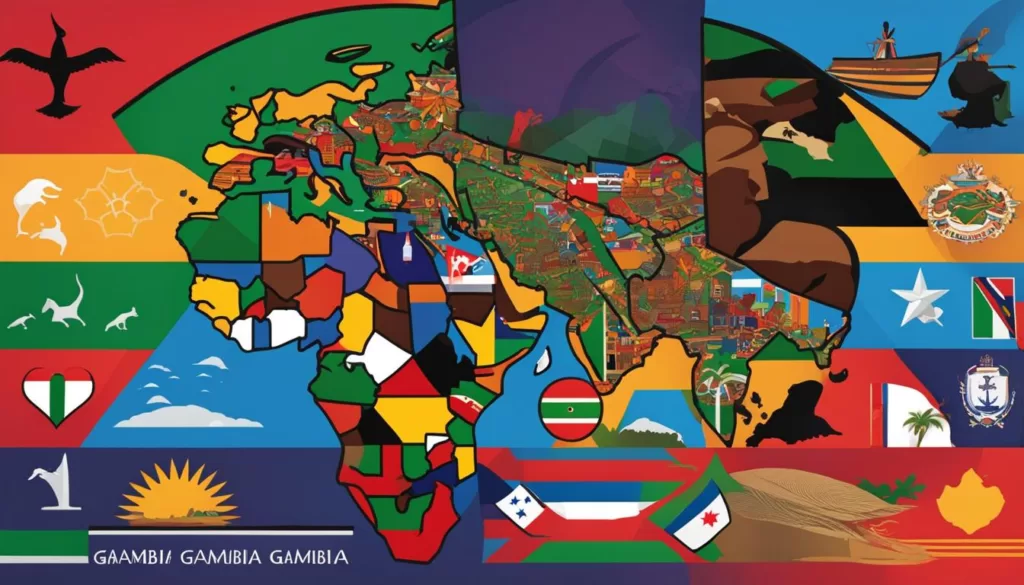
In a land where multilingualism is the norm, the linguistic landscape extends beyond the native dialects. French and Arabic are woven into the fabric of the conversation along Gambia’s border regions, influenced by the nation’s geographic proximity and historic ties to neighboring countries. Languages in West Africa are inherently diverse, and Gambia is a testament to this diversity, emblematic of a region where languages intertwine seamlessly, a hallmark of West African identity.
With most of the population speaking several languages, including English, there is a vibrant dynamic that reflects the nation’s cultural agility. The impressive language statistics Gambia reveal a society where code-switching is as natural as breathing, where marketplace haggling and political discourse alike glide across different languages with fluidity and grace.
| Language | Percentage Speaking as a First Language | Usage Context |
|---|---|---|
| Mandinka | 38% | Daily communication, cultural expressions |
| Pulaar | 21% | Community dialogues, traditional narratives |
| Wolof | 18% | Business transactions, informal interactions |
| English | 0.5% (but widely understood) | Education, official documentation, interethnic communication |
| Others (Soninke, Jola, etc.) | Varies | Vernacular literature, ethnic group traditions |
| French, Arabic | Not specified | Border-trade conversations, religious contexts |
In essence, the nation’s prowess in multilingual communication positions it not only as a unique member of the languages in West Africa but also as a compelling study of linguistic versatility. This rich tapestry, a polyglot’s dream, continues to be an integral part of Gambia’s identity, one thread interlocking with another to create the beautiful mosaic that is Gambia’s spoken word heritage.
Gambia’s Official Language: A Legacy of Colonialism
Rooted deeply in its colonial history, the official languages Gambia inherited form the bedrock of its educational and administrative frameworks. A legacy of British colonization, English continues to wield a major influence on the Gambian society, functioning as the primary medium for official discourse and education. This influence transcends mere governmental affairs, permeating the daily lives of Gambians, bridging the linguistic diversity inherent to the nation.
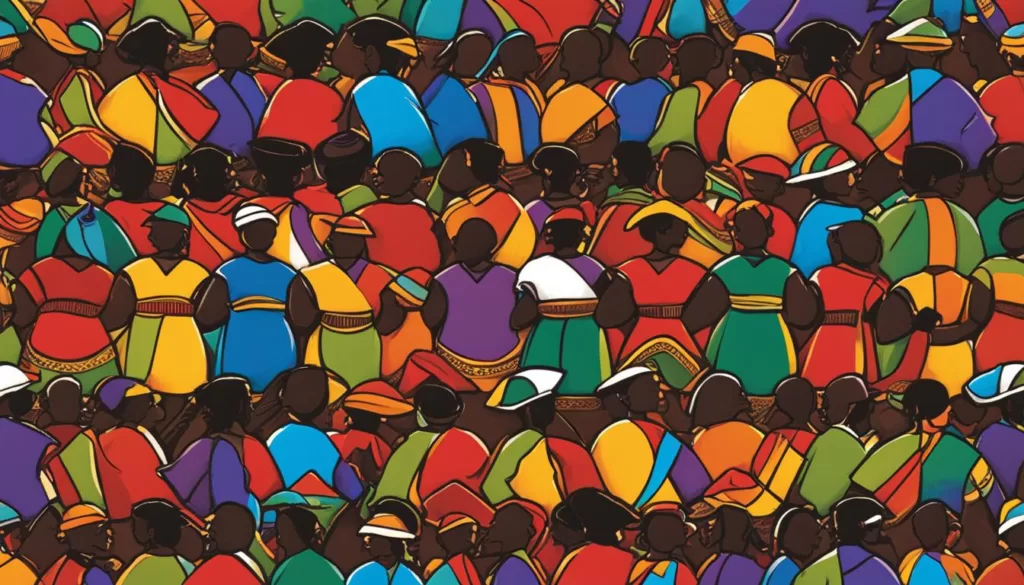
The Role and Use of English in Gambian Society
In Gambia, English is utilized not only for bureaucratic governance but also as a crucial cornerstone in the educational system. As the lingua franca of this West African nation, English facilitates interethnic communication, thereby amplifying connectivity within its pluralistic society. In the bustling streets of Banjul, English signs adorn government buildings and educational institutions, a testament to its pervasive use.
Educational Language Policies Impacting Linguistic Landscape
Language policies in Gambia’s education have a pivotal role in sculpting the country’s linguistic landscape. These policies champion English as the medium of instruction, ensuring the population’s bilingual, if not multilingual, proficiency. Nonetheless, these policies are also crafted with an awareness of the importance of the linguistic heritage Gambia prides itself on. Educational frameworks are increasingly taking proactive steps to integrate indigenous languages into the curriculum, highlighting a nation’s effort to preserve its cultural identity through language.
The intertwining of language and education in Gambia reveals a nuanced tapestry of linguistic heritage and modernity. It is within this interplay that Gambia charts its unique path, fostering both global communication skills and deep respect for its multi-ethnic roots.
The Dominance of Local Languages in Rural and Urban Areas
In the intricate web of Gambia’s societies, from the thrumming streets of its cities to the tranquil lifeblood of its villages, local languages Gambia serve as the cornerstone of cultural expression and daily communication. The linguistic fabric of Gambia is rich and complex, with a tapestry of idioms and dialects that make up the country’s communicative identity.
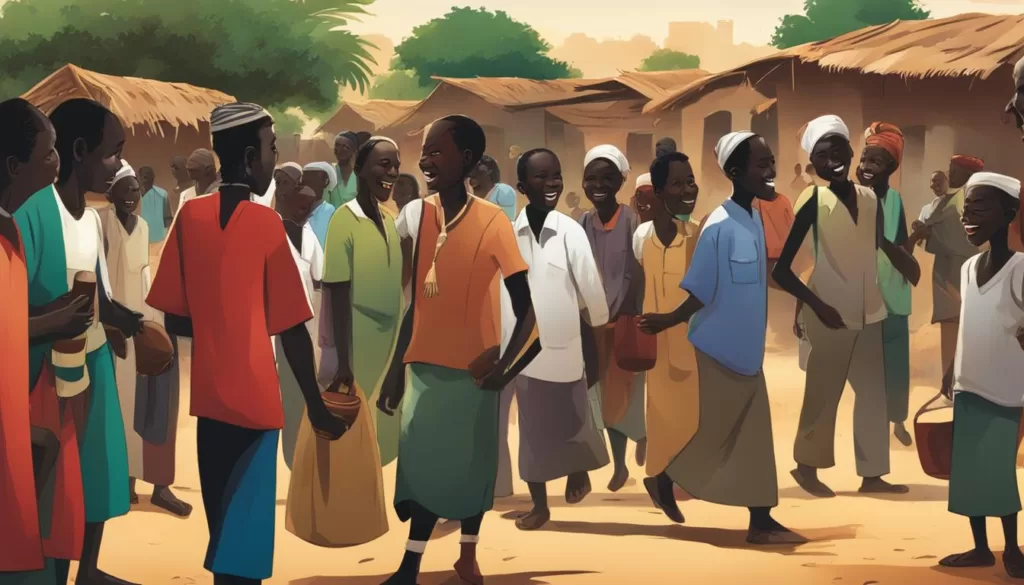
As the language diversity Gambia paints its rural and urban landscapes with an array of dialects, the sounds of Mandinka and Wolof fill the air, weaving together the national story with each spoken word.
Dissecting the Prevalence of Mandinka and Other Regional Languages
The prevalence of Mandinka, as a lingua franca in many parts of the Gambia, lends it a prominent role in the orchestration of everyday life. Alongside this, other regional languages such as Pulaar, Wolof, and a multitude of Gambian dialects equally contribute to the symphony of sounds that define Gambian society.
These languages are not static; they live, breathe, and evolve with each new generation, preserving the past while creating the future. Their dominance is most evident in rural areas, where these languages form the very essence of community life. Even within the hustle and bustle of urban centers, these vernaculars retain their vitality, providing continuity and a sense of belonging.
Language as a Social Connector Among Gambians
Across all echelons of Gambian society, language acts as a powerful social connector. It is the medium through which traditions are passed down, stories are told, and relationships are forged. The linguistic prowess of Gambians is partly due to their ability to navigate seamlessly across a variety of languages, which underscores the centrality of these local tongues in maintaining the social fabric of the nation.
Language is intrinsically linked to Gambian identity, and its use extends beyond mere conversation. It is employed in celebration and mourning, in trade and negotiation, and in the shared experiences that constitute everyday life. Through language, Gambians create an invisible network of bonds that binds different groups together in mutual understanding and cultural concord.
In conclusion, the local languages of Gambia stand as testaments to the country’s rich heritage and its dynamic present. They echo the pride of the people and the beauty of their land, ensuring that Gambia’s multifaceted voice continues to resonate both within and beyond its borders.
Gambian Dialects and Indigenous Languages
The rich tapestry of Gambian dialects and indigenous languages forms a cornerstone of the nation’s identity, weaving a narrative through the generations via oral traditions, history, and customs. Languages like Mandinka, Fula, and Wolof, along with regional variants such as the Fana Fana dialect, articulate the complexities and nuances of the Gambia’s sociolinguistic landscape. Even as the world becomes increasingly globalized, these languages retain their relevance, anchoring the people of Gambia firmly to their cultural roots.
In Gambia, the interplay of language diversity is vibrant and dynamic, enriching daily life with a spectrum of dialects and linguistic styles. The following table provides insights into the prevalence and use of various indigenous languages in Gambia, shedding light on the societal roles they play within communities.
| Indigenous Language | Dialect | Community Role |
|---|---|---|
| Mandinka | Standard Mandinka | Market interactions, traditional ceremonies |
| Wolof | Fana Fana | Social gatherings, inter-ethnic communication |
| Fula | Pulaar | Herding communities, folk narratives |
| Jola | Jola-Fonyi | Agricultural communities, folklore |
| Soninke | Standard Soninke | Trade, cultural heritage preservation |
Each Gambian dialect and indigenous language encapsulates a unique cultural story, helping to maintain the linguistic heritage of Gambia. They are not merely for communication but are also symbolic of the collective memory and shared experiences of the Gambian people. As the Gambia continues to interact with the global community, the resilience of these languages exemplifies the strength and continuity of Gambian cultural identity.
Language Statistics of Gambia and the Shifts Over Time
The linguistic tapestry of Gambia is a vibrant reflection of the nation’s rich history and cultural dynamism. Through the ages, Gambia’s language statistics have not only documented linguistic presence but also untold stories of societal change, migration, and education. These patterns, showcased in the language map of Gambia, offer fascinating insights into the nation’s evolving linguistic heritage.
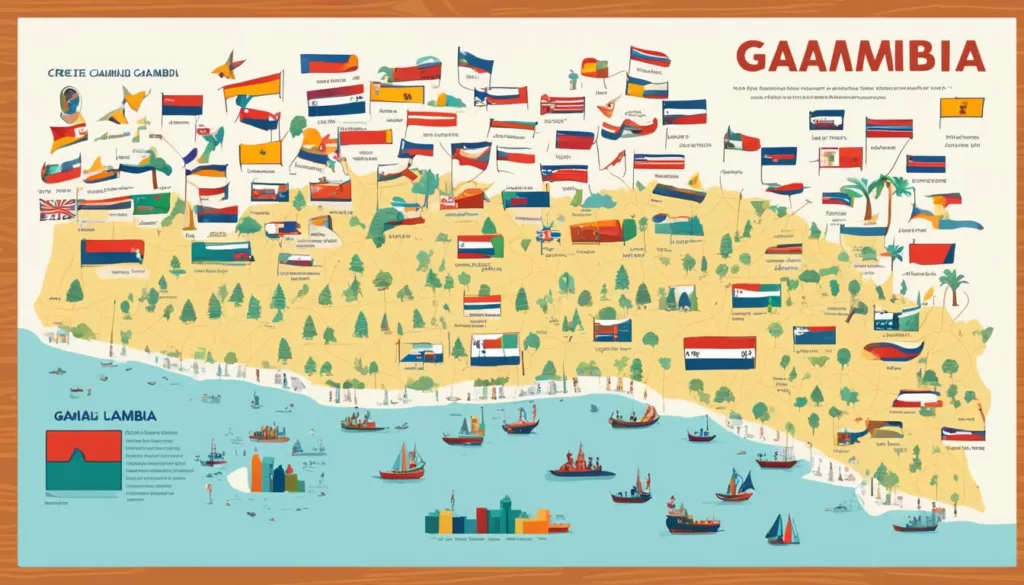
Analyzing Linguistic Heritage and Its Evolution in Gambia
Evolving language statistics in Gambia are indicators of broader socio-cultural dynamics. The current linguistic landscape has been shaped by historical influences and the perpetual flow of cultural exchange. The prominence of languages such as Mandinka, Wolof, and Pulaar remains, while the utilization of English in official and educational contexts signifies the country’s connective lingua franca. This enduring linguistic heritage of Gambia is an amalgamation of Africa’s complex storytelling tradition and the residues of colonial imprints.
Insights from Language Map Studies and Demographics
Demographic studies and language map analyses offer a panoramic view of Gambia’s linguistic composition. Radios broadcasting in up to five local languages testify to a nation’s pride in its linguistic diversity. Educational systems nurturing multiple languages reinforce the rich linguistic heritage of Gambia, while ongoing demographic shifts continue to influence the language landscape. As these changes overlay across the topographical language map of Gambia, they forecast a continued tradition of lingual pluralism, deftly captured through statistical observations and cultural recognition.
Conclusion
The intricate weave of language diversity Gambia is the heartbeat of a nation steeped in cultural majesty and the songs of its ancestors. A nation where the languages spoken Gambia resonate through the markets, schools, and myriad facets of daily life, crafting a vibrant tapestry that both reflects and celebrates the identity of its people. National languages Gambia proudly stand as pillars of heritage while opening doors to global dialogue, exemplifying a society that thrives within the kaleidoscope of its linguistic spectrum.
Gambia’s multilingual prowess is more than an academic observation; it is a lived experience that vibrantly showcases a society adept in navigating the complexities of linguistic plurality. In the mesh of centuries-old dialects and the lingua franca of wider communication, Gambians have mastered the art of language as a bridge between worlds – a bridge that unites and propels them into the future.
Embracing Gambian Linguistic Diversity in Our Globalized World
As our global society becomes ever more interconnected, the linguistic diversity within Gambia emerges as a beacon for cultural enlightenment and understanding. By valuing and maintaining this linguistic plurality, the Gambia not only safeguards its own rich cultural narrative but also contributes to the global tapestry, sharing with the world a model of harmonious linguistic coexistence.
The Future of Multilingualism in Gambia
The continuing legacy of multilingualism in Gambia is painted with both the delicate strokes of tradition and the broader swathes of modern influence. It is a future that rests on the keystone of education, respect for cultural roots, and the adaptive strategies of a nation on the precipice of global change. In fostering the flourishing of its numerous tongues, Gambia steadies its course towards a future where its many voices will resonate ever more profoundly—and harmoniously—with the rest of the world.
FAQ
What languages are spoken in Gambia?
Gambia is home to a diverse array of languages. English is the official language used in government and education. Indigenous languages are also widely spoken, including Mandinka, Pulaar, and Wolof being the most prevalent. Other languages spoken are Soninke, Jola, Serer, Manjak, Bainouk, and Gambian Sign Language is used by the deaf community.
How does language reflect Gambia’s culture and identity?
Language in Gambia is a reflection of its rich cultural identity and diversity. Each ethnic group has its own native tongue which is used in daily life, expressing traditions, and history. The multilingual nature of Gambians, connected by the English language, showcases the country’s cultural complexity and societal bonds.
What are Gambia’s national languages?
While English is the official national language of Gambia, indigenous languages such as Mandinka, Pulaar, and Wolof are considered national languages due to their wide usage and cultural significance. These languages contribute to the multilingual character of the nation within the West African context.
What role does English play in Gambian society?
English serves as the medium for official communication, education, and government in Gambia. It’s the legacy of British colonial rule and continues to operate as a lingua franca, bridging the diverse ethnic languages present in the country.
How do educational language policies impact Gambia’s linguistic landscape?
Educational language policies in Gambia advocate for instruction primarily in English, reinforcing its role in society. However, there is also a focus on preserving and promoting Gambian linguistic heritage, with initiatives to integrate local languages into the educational system.
How prevalent are local languages in Gambian daily life?
Local languages such as Mandinka, Pulaar, and Wolof are dominant in daily life in both rural and urban areas in Gambia. They serve as the primary means of communication and are integral to maintaining cultural practices and social connections.
What is the significance of Gambian dialects and indigenous languages?
Gambian dialects and indigenous languages are vital to the country’s sociolinguistic fabric. They are not only used for daily communication but also carry oral traditions, historical narratives, and cultural values. They remain relevant in a globalized world and are key to the nation’s cultural continuity.
How have language statistics in Gambia changed over time?
Language statistics in Gambia show a dynamic multilingual environment influenced by historical events, including colonialism and migration. These changes over time are tracked through language map studies and demographics, which highlight the evolving linguistic heritage of the country.
What insights do language map studies and demographics offer?
Language map studies and demographics offer insights into the distribution and prevalence of different languages across Gambia. They help us understand the regional concentration of languages, their utilization patterns within communities, and the broader linguistic shifts occurring over time.
How does Gambia embrace linguistic diversity in our globalized world?
Gambia embraces its linguistic diversity by recognizing the importance of multiple languages in reflecting its cultural tapestry. Multilingualism is celebrated, and efforts are made to preserve native tongues while also engaging with global languages and cultures.
What is the future of multilingualism in Gambia?
The future of multilingualism in Gambia looks to maintain a balance between valuing the nation’s linguistic heritage and the practicalities of globalization. Policies and educational programs will play a crucial role in promoting language diversity and fostering a multilingual society.






